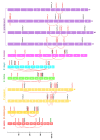Genome-wide, evolutionary, and functional analyses of ascorbate peroxidase (APX) family in Poaceae species
- PMID: 36512713
- PMCID: PMC9747090
- DOI: 10.1590/1678-4685-GMB-2022-0153
Genome-wide, evolutionary, and functional analyses of ascorbate peroxidase (APX) family in Poaceae species
Abstract
Ascorbate peroxidases (APXs) are heme peroxidases involved in the control of hydrogen peroxide levels and signal transduction pathways related to development and stress responses. Here, a total of 238 APX, 30 APX-related (APX-R), and 34 APX-like (APX-L) genes were identified from 24 species from the Poaceae family. Phylogenetic analysis of APX indicated five distinct clades, equivalent to cytosolic (cAPX), peroxisomal (pAPX), mitochondrial (mitAPX), stromal (sAPX), and thylakoidal (tAPX) isoforms. Duplication events contributed to the expansion of this family and the divergence times. Different from other APX isoforms, the emergence of Poaceae mitAPXs occurred independently after eudicot and monocot divergence. Our results showed that the constitutive silencing of mitAPX genes is not viable in rice plants, suggesting that these isoforms are essential for rice regeneration or development. We also obtained rice plants silenced individually to sAPX isoforms, demonstrating that, different to plants double silenced to both sAPX and tAPX or single silenced to tAPX previously obtained, these plants do not show changes in the total APX activity and hydrogen peroxide content in the shoot. Among rice plants silenced to different isoforms, plants silenced to cAPX showed a higher decrease in total APX activity and an increase in hydrogen peroxide levels. These results suggest that the cAPXs are the main isoforms responsible for regulating hydrogen peroxide levels in the cell, whereas in the chloroplast, this role is provided mainly by the tAPX isoform. In addition to broadening our understanding of the core components of the antioxidant defense in Poaceae species, the present study also provides a platform for their functional characterization.
Conflict of interest statement
Figures








References
-
- Agrawal GK, Jwa NS, Iwahashi H, Rakwal R. Importance of ascorbate peroxidases OsAPX1 and OsAPX2 in the rice pathogen response pathways and growth and reproduction revealed by their transcriptional profiling. Gene. 2003;11:93–103. - PubMed
-
- Akbudak MA, Filiz E, Vatansever R, Kontbay K. Genome-Wide identification and expression profiling of Ascorbate Peroxidase (APX) and Glutathione Peroxidase (GPX) genes under drought stress in Sorghum (Sorghum bicolor L.) J Plant Growth Regul. 2018;37:925–936.
-
- Asada K. The water-water cycle in chloroplasts, scavenging of active oxygen and dissipation of excess photons. Annu Rev Plant Physiol Plant Mol Biol. 1999;50:601–639. - PubMed
LinkOut - more resources
Full Text Sources
Miscellaneous

